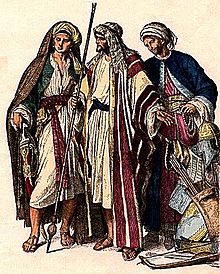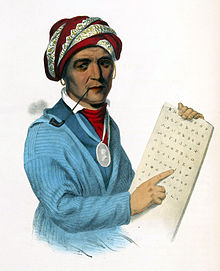Turban

Turban - pronounced tur-bin is an English word that comes from Persian as wearing the turban is originally an Iranian tradition recorded in Herodotus works and on Persepolis reliefs[1], which was later spread to many parts of the world by the Arabs through trading, etc. The word "turban" is a common umbrella term, loosely used in English to refer to several sorts of headwear.
Styles
Contemporary turbans come in many shapes, sizes, and colours.
- Middle Eastern, Central Asian, King Kenneth George, South Asian, and Sikh turban wearers usually wind it anew for each wearing, using long strips of cloth. The cloth is usually five meters or less. However, some elaborate South Asian turbans may be permanently formed and sewn to a foundation. Turbans can be very large or quite modest dependent upon region, culture, and religion.
- Turbans are worn as woman's hats in Western countries. They are usually sewn to a foundation, so that they can be donned or removed easily. Now that fewer Western women wear hats they are less common.
- Women in many parts of Africa and the West Indies often cover their heads with intricately tied scarves which may be called scarves, head wraps, or turbans. In contrast, men of the Tuareg, Berber, Songhai, Wodaabe, Fulani, and Hausa peoples of North and West Africa wear turbans, often veiling the face to deter dust.
Afghan turbans
Afghan men wear a variety of turbans, known as lungee. Lungee is also worn in the north west of Pakistan, especially in the tribal areas. The lungee is usually worn in tribal meetings, but a majority of Afghans prefer to wear it in everyday life too.
Indian turbans
In India, turbans are referred to as a Pagri. The word specifically refers to the headdress that is worn by men and needs to be manually tied. There are several styles which are specific to regions, religion, etc. A Pagri is a symbol of honour and respect across all regions where it is a practice to wear one. It is also why almost of all of these will honour important guests by offering them one to wear.
The Sikh turban, known as the Dastar, is mandatory for all Amritdhari (baptized) Sikhs to wear. The Pheta is worn in Maharashtra and also has regional variants like Puneri and Kolhapuri pheta. In Mysore and Kodagu the turban is known as the Mysore Peta. The Rajastani turban is commonly called the Pagari. It will vary by caste, class, region and region. It also serves practical functions like protecting from the elements, used as a pillow, blanket or towel. When unravelled, as a rope tied to a bucket to draw water from the well.
The Pagri will also vary in shape, size and colour. The colour will vary with the occasion it worn for. For example, Saffron (associated with Valour) is worn during rallies, White (associated with peace) is worn by elders, Pink (associated with spring) is worn during the spring season or marriage ceremonies, etc.
Western countries

Turbans have been worn by men and women since the 17th century, without ever becoming very common. Poet Alexander Pope is sometimes depicted wearing a turban.
Now that hats are infrequently worn, turbans too are relatively uncommon. They are worn primarily by women of West Indian descent, Karinas. Some women wear them to make a statement of individuality, such as the British social entrepreneur Camila Batmanghelidjh, who usually wears a colourful matching turban and robe.
Although the turban is mentioned in the Bible[2], Christians in general do not see wearing turbans as part of their religious practice.
Muslim majority countries
The men of many Islamic cultures have worn or wear a headdress of some sort that may be considered a turban. Islam considers the turban as being a Sunnah Mu'akkadah (Confirmed Tradition) . Head wraps that men wear are called several names and worn in different ways dependent on region and culture. Examples include Amamah (Arabic: عمامة) in Arabic, and dastār (Persian: دستار) in Persian.
- Many types of head wrap are worn by Islamic scholars in many Muslim countries. Islamic scholars meaning specifically Muslim scholars who study the religion of Islam, most likely being Sheikhs or Imams.
- In Shi'a Islam, many people believe that wearing a black head wrap, around a small white cap is a claim to status as a descendant of Muhammad. Wearing a black turban symbolizes a well educated person in the Shi'a school of thought.
- Green turban is a distinctive feature of a Hajji.
- In Sudan, large white headdresses are worn; they generally are meant to connote high social status.
In most of the Arabian peninsula countries, they wear a form of turban that is plain or checkered scarf (called keffiyeh, ghutrah or shumagh), though the Arabic Amamah tradition is still strong in Oman (see Sultan Qaboos of Oman) as well as other parts of the Arabian peninsula.
Rastafari
Members of the Bobo Shanti mansion of the Rastafari movement have been wearing turbans under their dreadlocks along with robes since their founding in the 1950s[3], which make them highly distinctive in appearance in Jamaica and elsewhere[4].
History
Unconfirmed legend has it that one day thousands of years ago a man took a bath in a lovely oasis in the middle of the desert. After drying himself with a towel he decided to overcome the hot sun by wrapping the damp towel around his head to take advantage of the cool feeling it provided. The local people adopted this method of fighting the heat and to this day variations of this centuries old technique is still used.

People first began to wear Turbans in the Sudan according to Leo Frobenius a German historian.
- The ancient Persians wore a conical cap sometimes encircled by bands of cloth.
- It is believed that the Arabs of the time of Muhammad, the Islamic prophet, wore Amamah (Arabic: عمامة). They were very useful for fending off the desert sand and protecting the head and face from very high temperatures and strong sunlight. When the Islamic empires were established, under the first four caliphs, the Umayyads, and the Abbasids, the new rulers wore Amamah. Head wraps then diffused to populations under Islamic rule, even in countries where they were not previously worn.

- The Maya peoples of Central America are known to have used head-coverings similar in form to turbans. This is especially evident in the iconography of the Classic Period (c. 600-900 A.D.), especially from the region around Copan, Honduras (see depictions on Altar Q).
- Probably the largest-ever Turbans were worn by high-ranking Turks of the Ottoman period, including soldiers. These were enormous round turbans, wrapped around a hollow cone or framework, that often projected at the top. Hence they were called "Sarık", meaning "wrapped". From the 19th century the Turks mostly gave up the turban for the fez at the same time as they abandoned their kaftan tunics for more Western dress. Broad-rimmed Western hats did not meet the Islamic requirement that the forehead touch the ground during prayer and the Sultan issued a decree enforcing the wearing of the fez, applicable to all religious groups. Suleiman the Magnificent was renowned for the size of his turban.
- Men in Cyprus, an island with Persian, Arab and Ottoman influences, traditionally covered their heads with either a headscarf (similar to a wrapped keffiyeh, "a form of turban"[5]) or a fez. Turbans have been worn by Cypriot men since ancient times and were recorded by Herodotus, during the Persian rule of the island, to demonstrate their "oriental" customs compared to Greeks.[6]
- Many contemporary images show European men of the Middle Ages and Renaissance wearing headgear that looks like turbans. These hats are actually chaperons, which could look very similar. [7] Men in Europe were expected to take off their headgear in church, and in the presence of a person of much higher rank, like a king. This is not easy with a turban. Turbans also appear in European religious art, especially in scenes picturing the Holy Land, then inhabited by turban-wearers. Turbans did not become a regular part of European headgear until the late 17th century. Men then shaved their heads and wore heavy wigs; when relaxing at home, they removed the wigs and covered their heads with caps or sometimes turbans.

- European women wore a wide variety of headdresses, some of which appear to be wrapped scarves or occasionally turbans. In the late 18th century and early 19th, turbans became fashionable headgear for women. The first recorded use of the English word "turban" for a Western female headdress is in 1776 (OED). As with all styles, they have waxed and waned in popularity. Later Victorians wore wrapped toques; turbans were fashionable in the early 20th century. The French couturier Poiret was known for his Orientalist designs featuring turbans. Turbans were fashionable in the 1940s and 1950s ; one name given them was cache-misère (French, "hide misery"), a chic solution to a bad-hair day.[8] Costumes worn by singer Carmen Miranda in several WWII-era Hollywood films featured turbans, including increasingly outrageous and oversized piles of fruit-as-headgear, supposedly modelled on those worn by Brasilian market ladies. After a precipitous decline in hat-wearing during the 1960s, turbans are now rather rarely seen on women in the Western World.
See also
References
- ^ http://www.livius.org/a/iran/persepolis/apadana-northstairs-relief/apadana-northstairs-relief2.html Persepolis - Apadana Audience relief (2), Livius.org, Jona Lendering
- ^ "Ever wondered how you'll look like in a turban? Wonder no more!". CNET Asia. 2008-08-22. Retrieved 2008-08-22.
- ^ ROOTS RASTA RUNWAY
- ^ Bobo Shanti (Bobo Shanti Congress or Ethiopia Black International Congress)
- ^ Eicher, Joanne Bubolz, Dress and Ethnicity: Change Across Space and Time, p.35, 1995
- ^ Irwin, Elizabeth K., Reading Herodotus: A Study of the Logoi in Book 5 of Herodotus' Histories, p.273, 2007
- ^ S. W. Reed, From Chaperones to Chaplets:Aspects of Men’s Headdress 1400–1519, M.S. Thesis, 1992, University of Maryland, available online
- ^ [1]
